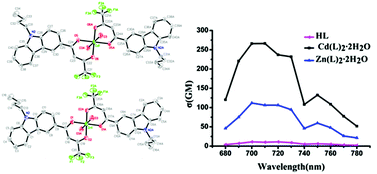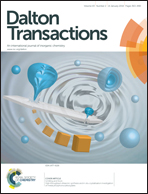Two novel six-coordinated cadmium(ii) and zinc(ii) complexes from carbazate β-diketonate: crystal structures, enhanced two-photon absorption and biological imaging application†‡
Abstract
To explore the photophysical properties of coordination compounds with enhanced two-photon absorption, two novel six-coordinated metal complexes (ML2, M = Cd(II), Zn(II)) from carbazole β-diketone ligand (HL = 4,4,4-trifluoro-1-(9-butylcarbazole-3-yl)-1,3-butanedione) were prepared and fully characterized. Their crystal structures were determined by X-ray diffraction analysis. Both variable temperature 1H NMR spectra and MALDI-TOF mass spectrometry proved that the coordination compounds exhibit good stability in solution. The results of time-dependent density functional theory (TD-DFT) calculations indicated that the complexation of the ligands with metal ion extends the electronic delocalization in the coordination compounds, leading to enhanced two-photon absorption. The photophysical properties for the coordination compounds were identified relying on both experimentally and theoretically studies. Finally, confocal microscopy and two-photon microscopy fluorescent imaging of HepG2 cells labeled with the Zn(II) complexe revealed its potential applications as a biological fluorescent probe.


 Please wait while we load your content...
Please wait while we load your content...